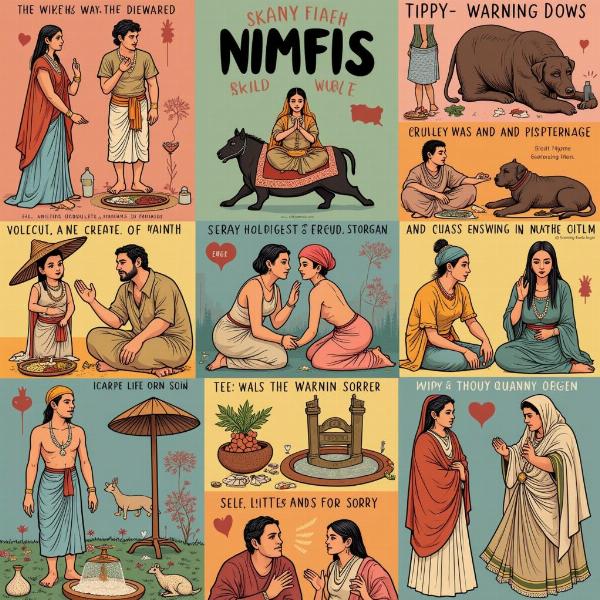The search for “sorrowing meaning in Hindi” often stems from a desire to express or understand deep sadness and grief. This article explores the various nuances of sorrow in Hindi, offering a comprehensive look at its cultural context and linguistic expressions. We’ll delve into the rich vocabulary of Hindi, exploring synonyms, idioms, and cultural connotations associated with sorrow, helping you grasp its profound meaning and significance in Indian culture.
Expressing Sorrow in Hindi: A Rich Tapestry of Words
Hindi, like any rich language, boasts a diverse vocabulary to capture the multifaceted nature of sorrow. From the common dukh (दुख) to the more poetic shok (शोक), each word carries its own weight and emotional depth. Understanding these nuances is key to truly appreciating the expression of sorrow in Hindi. Think about the difference between afsos (अफ़सोस), which implies regret, and gham (ग़म), which signifies a deeper, more pervasive sadness. These subtle distinctions allow for a more precise and nuanced communication of emotional states.
Cultural Contexts of Sorrow in Hindi
Sorrow in Hindi isn’t just a personal experience; it’s deeply interwoven with cultural and religious beliefs. Hindu scriptures offer perspectives on sorrow, often viewing it as an inevitable part of life, a consequence of karma, or a path to spiritual growth. Consider the concept of viraha (विरह), the sorrow of separation, often explored in literature and music, particularly in the context of divine love. This cultural understanding shapes how sorrow is expressed and experienced within Indian society.
Idioms and Proverbs Related to Sorrow
Hindi idioms and proverbs offer a glimpse into the cultural understanding of sorrow. Phrases like dil dukhna (दिल दुखना – to feel heartache) and aankhen bhar aana (आँखें भर आना – eyes welling up with tears) vividly portray the physical and emotional manifestations of grief. These expressions, passed down through generations, reflect the shared experiences and cultural wisdom surrounding sorrow.
Sorrow in Hindi Literature and Music
Hindi literature and music are replete with expressions of sorrow, often exploring themes of loss, longing, and the transient nature of life. From the poignant poetry of Kabir to the melancholic melodies of classical ragas, these art forms provide a powerful medium for expressing and processing grief. This deep connection between sorrow and artistic expression further underscores its significance in Indian culture.
How do you say “I am sorrowing” in Hindi?
If you’re looking to express “I am sorrowing” in Hindi, the most appropriate translation depends on the specific nuance you want to convey. Mai dukhi hun (मैं दुखी हूँ) is a common way to express general sadness. For deeper grief, you might say Mai gham mein hun (मैं ग़म में हूँ). Choosing the right word depends on the intensity and context of your sorrow.
What is the difference between dukh and shok in Hindi?
While both dukh and shok relate to sorrow, shok specifically refers to grief related to the death of someone. Dukhi (दुखी) signifies general sadness or unhappiness, while shokgrast (शोकग्रस्त) describes someone overwhelmed by grief due to bereavement. This distinction highlights the specific vocabulary Hindi uses to differentiate between types of sorrow.
Conclusion: Embracing the Complexity of Sorrow in Hindi
Understanding “sorrowing meaning in Hindi” requires more than just a simple translation. It involves delving into the rich linguistic, cultural, and artistic expressions that shape its meaning. From everyday conversations to profound literary works, sorrow is an integral part of the human experience, and Hindi offers a nuanced and expressive vocabulary to capture its complexities.
FAQ:
-
What is the most common word for sorrow in Hindi? Dukhi (दुखी).
-
How do you express deep grief in Hindi? gham (ग़म), shok (शोक).
-
What are some Hindi idioms related to sorrow? Dil dukhna (दिल दुखना), aankhen bhar aana (आँखें भर आना).
-
How does Indian culture view sorrow? Often as an inevitable part of life, sometimes linked to karma or spiritual growth.
-
Where can I find examples of sorrow in Hindi literature? In the works of poets like Kabir, as well as in various religious texts and folk tales.
 Sorrow in Indian Culture: Rituals and Expressions
Sorrow in Indian Culture: Rituals and Expressions
Meaning-Hindi.in is your trusted partner for all your Hindi translation needs. We offer a wide range of professional translation services, including business and commercial document translation, certified and legal document translation, technical and user manual translation, website and localization services, and educational and academic document translation. Our team of expert Hindi linguists ensures accurate and culturally sensitive translations, tailored to your specific requirements. We also offer quick and specialized translation services for diverse industries. Contact us today for a free quote and discover how Meaning-Hindi.in can bridge the language gap for you. Email: [email protected], Phone: +91 11-4502-7584.